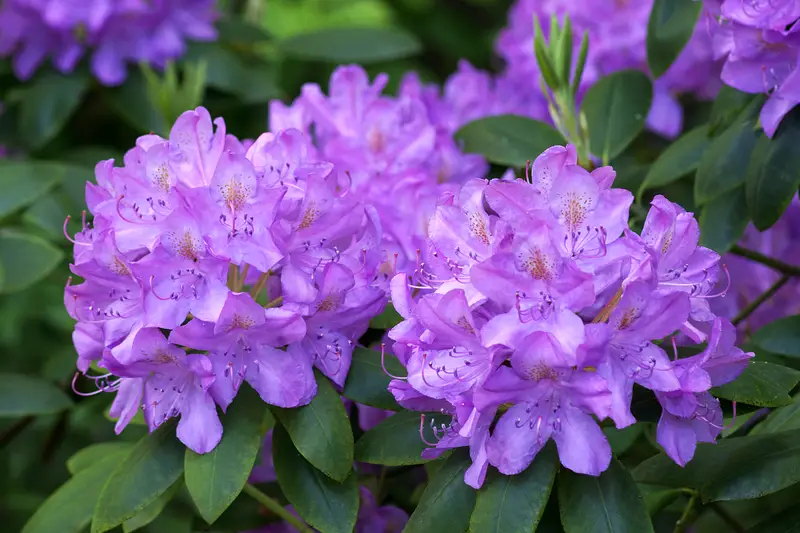Coming across your rhododendron having yellow leaves is very disheartening. However, you’ve got to start dealing with it buddy. Otherwise, you might lose your beautiful rhododendron plant.
So, why are your rhododendron leaves turning yellow all of a sudden?
Well, for starters, the yellowing of the leaves can take place if your soil isn’t well-drained. Then iron chlorosis can be another reason. The fungus named Cercospora can cause rhododendron leaves to turn yellow as well. Lastly, if you plant rhododendron too deep, its leaves might turn yellow.
However, there’s more to this. We’ve explained the causes extensively along with their solutions. Therefore, be sure to read till the end if you’ve got enough time.
Now let’s get to know the details-

As an Amazon Associate I earn from qualifying purchases.
Causes & Solutions for Rhododendron Yellow Leaves
You might come across yellow leaves on your rhododendron while growing it. But you can definitely fix this problem, if it’s not that severe.
Now, there can be four reasons why the rhododendron leaves are turning yellow. So, on that note, we’ve explained the causes and their solutions-
Cause 1 of 4: Soil too Wet for Rhododendron
Now the first thing you need to do is to check the soil. Because you see, rhododendron isn’t friendly with wet soil. Therefore, if your soil isn’t well-drained, there’s a high chance that the leaves of the plant will turn yellow.
So, what can you do to stop the yellowing?
Solution
Well, the solution is quite simple. You just have to replant your rhododendron where the airflow and drainage are better. Use a pot with good drainage holes if you’re an indoor gardener.
To be sure about the wet soil issue, you can take some of the soil in your hand and squeeze it. If the soil stays together and doesn’t break apart then the soil is wet.
Cause 2 of 4: Unsuitable pH Level Leading to Iron Chlorosis
The pH level of your soil needs to be around 4.5 -5.5 for your rhododendrons to thrive.
However, sometimes the pH level of your soil can change and become alkaline. And that alkali soil sometimes causes “Iron Chlorosis”. For which you’ll find rhododendron plant leaves turning yellow.
So, how can you tell if the pH level has changed or not?
The answer is testing the pH level of the soil with the help of a pH meter. For you, we’ve suggested some of the best pH meters-
| Our Recommended pH Meter |
| VIVOSUN pH and TDS Meter Combo Bluelab PENPH pH Pen |
After testing the soil, you’ve to take the necessary steps to bring the proper pH level back. Now some of you might be unsure about whether your plant has ‘iron chlorosis’ or not.
Well, to be sure, just pour a little bit of vinegar on the soil. And if you see bubbles then your poor rhododendron surely has iron chlorosis.
Solution
Now, don’t get restless. Because there’s a simple way of getting rid of it.
To get the acidity back, you can use two specific things. And these two are-
- Soil acidifier and
- Chelated iron
Just add a small amount of either to the soil at the beginning. And then check the pH level again. Add more if the soil is still alkaline. But don’t add too much at the beginning because low pH can cause yellowing as well.
Cause 3 of 4: Fungal Attack Causing Cercospora Leaf Spot
Cercospora leaf spot is a fungal disease. And it’s caused by a fungus named Cercospora handelii. This very fungal disease can be the reason why your rhododendron leaves are turning yellow.
Furthermore, you can blame this disease even when you see rhododendron leaves turning yellow with brown spots.
Now, how serious can this disease get?
Well, as far as we know, it does get pretty serious. Because this disease can cause the leaves of the plant to die. And the death of the leaves indicates that the plant is also dying slowly.
Solution
So, how to save a dying rhododendron?
Well, cutting and destroying the diseased and dead leaves are the first things you should do. Because that’ll reduce the possibility of the spread of the disease.
After that, you can use a fungicide to kill the fungus. On that note, we’ve mentioned some fungicides for you down below-
Now just take care of the plant properly and you’ll see the yellowing has stopped.
Cause 4 of 4: Planted too Deep
Rhododendron leaves can get yellow if it’s planted too deep. How to tell if it’s planted too deep or not?
Well, you can check that by trying to touch the root ball. Here root ball refers to the main mass of roots. If you can’t touch it then there you go, your rhododendron is planted too deep.
Solution
So, what can be done?
The first you can do is lift the rhododendron and replant it at the right level. You’ve to dig a hole that is as deep as the rhododendron root ball. And then plant it. See? It’s not that hard.
Therefore, don’t worry just follow the procedure and your plant will stop turning yellow.
FAQs
Question: How do you treat yellow leaves on rhododendrons?
Answer: Well, at first, you’ve to identify the cause. And only then you can move on to the treatments. For example, if a fungus caused the yellow leaves, then a good fungicide will do the work. But if the yellow leaves took place due to iron chlorosis, you’ll have to use chelated iron.
Question: Why is rhododendron leaves turning yellow in summer?
Answer: In the summer, your rhododendron leaves can get yellowish. Especially if you don’t provide sufficient water. It can also get yellow leaves if you don’t feed the plant properly. Deeply watering the plant 2-3 times a week and using an all-purpose fertilizer will stop the yellowing.
Question: Why is my potted rhododendron leaves turning yellow?
Answer: Iron chlorosis can be a reason behind this. You need to check the pH level of the soil to be sure and then add chelated iron to the soil. You should keep on adding until the pH level is around 4.5-5.5.
Conclusion
So, that’s all we could provide on rhododendron leaves turning yellow. By now we hope you’ve identified what actually turned the leaves yellow.
Were you able to save your rhododendron?
Comment down below to share your answer with us by commenting. And lastly, good luck and have a great day, my friend!
